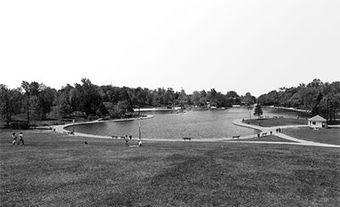John Hamilton Andrews
John Hamilton Andrews (b October 29, 1933, Sydney, Australia), architect, graduated with a bachelor of architecture from the University of Sydney in 1956, worked for the Sydney firm of Edwards Madigan Torzillo in 1957, and earned a master of architecture degree from Harvard University's Graduate School of Design (GSD) in 1958. That same year his submission to the international competition for Toronto City Hall was selected as a finalist, only to lose in the final selection to the entry by Finnish architect Viljo Revell. Andrews's success in the competition took him to Toronto, where he worked on the City Hall project with John B. Parkin Associates, who worked on the execution of Revell's winning design.In 1962 John Andrews left Parkin to become chairman of the University of Toronto's program in architecture, a position he held until 1967. He established John Andrews Architects in 1962, and quickly came to prominence with the design of Scarborough College on the outskirts of Toronto (1963-69, with Page and Steele Architects). The project was an early Canadian example of the sculptural use of concrete and the internalized megastructure approach that responded to the need to accommodate a rapidly growing population in a harsh winter climate.
Internationally recognized as representative of a new approach to post-secondary education as the baby boom generation reached university age, this large and ambitious landscape-related scheme typified a bold new spirit that emerged in Canadian architecture in the years surrounding the nation's centennial (1967).
Scarborough College was followed with a variety of academic buildings throughout Ontario, including student housing at the University of Guelph and the library at the University of Western Ontario in London. In 1968 Andrews won the commission to design Gund Hall, a new building for his alma mater, Harvard University's GSD (completed 1972). His firm served as design architects on the multidisciplinary team that designed Toronto's CN Tower, which was the world's tallest free-standing structure from 1976 to 2007. Other prominent projects in North America include the Miami Seaport Passenger Terminal, Miami, Florida (1970); the Kent State University School of Art in Ohio (1972); and the Intelsat Headquarters in Washington, D.C. (1988).
In 1973 Andrews expanded his practice into his native Australia, where it was transformed into John Andrews International Pty Ltd. His firm executed a number of prominent projects, including the Hooker Tower in Sydney (1974), student housing at the University of Canberra (1971-75), King George Tower in Sydney (1976), and offices for the Australian Federal Government in Canberra (1973-76).
John Andrews has been the recipient of many honours, including a Centennial Medal (Canada); a Massey Medal (Canada); the Arnold Brunner Award, National Institute of Arts and Letters (U.S.); and an Ontario Association of Architects 25 Year Award for Scarborough College. He is a Fellow of the Royal Architectural Institute of Canada and of the Royal Australian Institute of Architects (RAIA), and a recipient of the RAIA Gold Medal and of an Honor Award from the American Institute of Architects.

 Share on Facebook
Share on Facebook Share on X
Share on X Share by Email
Share by Email Share on Google Classroom
Share on Google Classroom


